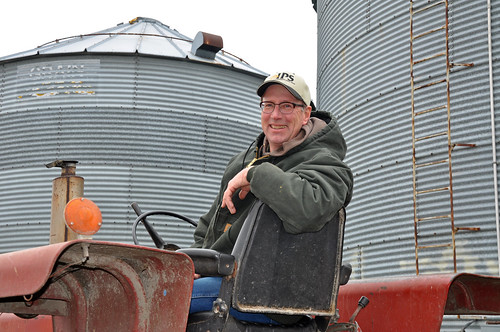
David Petersen takes extra steps to ensure his dairy in southeast Iowa does not impact water quality downstream. Through voluntary conservation work, he prevents manure from washing off the dairy into the nearby Cedar, Iowa and Mississippi rivers.
Majestic Manor, run by Peterson and his wife Amy, has been in the family for four generations. They milk about 120 Holstein dairy cows twice daily and also grow corn, alfalfa, oats, triticale and soybeans on about 320 acres. Petersen likes to refer to his operation as “closed-loop” where the soil feeds the crops, the crops feed the cattle, and the cattle feed the soil. “It is a benefit to everyone,” he says.
To more safely store and better use liquid dairy manure, Petersen installed a waste storage facility in 2001 with planning and financial assistance through USDA’s Natural Resources Conservation Service (NRCS). The storage structure can hold up to a half million gallons of liquid manure, which Petersen injects into his crop fields for nutrients. The manure storage structure sits below slotted livestock flooring, allowing manure to permeate to a concrete pit.
To participate in NRCS financial assistance programs, farmers like Petersen must first develop a conservation plan for their farm. The plan helps farmers prioritize resource concerns, which in Petersen’s case was improving water quality through manure management practices – including storage and application.
Petersen received financial assistance through the Environmental Quality Incentives Program (EQIP) to offset the cost of his waste storage structure. EQIP is a locally led, voluntary USDA program that provides private landowners assistance to install conservation practices to treat natural resource concerns.
“We have a direct impact on water quality to the Mississippi River, and we take that seriously,” said Petersen.
In 2006, Petersen came to NRCS in need of assistance to design a grassed waterway to slow water entering the farm from the east. Grassed waterways reduce soil erosion in locations where gullies form naturally from concentrated water flows.
Through the conservation planning process, NRCS recommended Petersen install a vegetated treatment area to address potential manure runoff contamination from his livestock loafing area. With financial assistance through EQIP, Petersen installed the grassed waterway, which help filter nutrients like manure.
A third EQIP-funded project is providing Petersen energy savings, and improving efficiency in his dairy operation. Through a practice called farmstead energy improvement, Petersen received NRCS assistance to retrofit 72 eight-foot T12 florescent lights with efficient light-emitting diode (LED) lamps.
LED lighting consumes about 50 percent less energy than T12 florescent lights and lasts much longer. Research indicates that dairy cows respond to a photoperiod of 16 hours of daylight, or its equivalent. And Petersen says the LED lamps, combined with a timer and photo eye, provide the light intensity his cows need to produce well.
Petersen now participates in the Conservation Stewardship Program (CSP), which is designed to help conservation-minded farmers and ranchers take their conservation efforts to the next level.
“These projects are for the benefit of everybody,” said Petersen. “We are conserving soil and improving water quality, in addition to improving the economic impact of our business. USDA has been a partner with us from day one. I consider myself a poster child for what can happen when you combine good public policy and good public funding with good private initiative.”
Petersen’s farm was recently highlighted on the public television show, “This American Land.” Watch the segment, “Farming the Upstream,” that showcases their conservation efforts.
